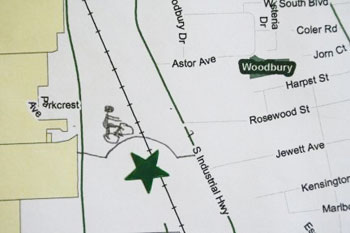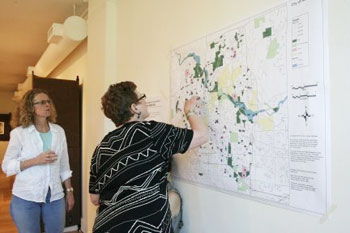The Where and Why of Ann Arbor’s Art

At an open house hosted by the Ann Arbor Public Art Commission, people were asked to mark the locations in town where they'd like to see public art. Sophie Grillet drew in a bike bridge she'd like to see over the railroad tracks on the south part of town, connecting South State and South Industrial.
A trio of women stood staring at the piece of paper on the wall, pencils and shiny star stickers poised in their hands. One of them announces she wants to mark somewhere with a bench. Somewhere she can sit and look.
The paper they’re looking at is a map of Ann Arbor. The stickers and pencils are tools to highlight places they think could use some artwork. On a bench below the map, there’s also a suggestion box, with squares of paper scrawled with the public’s suggestions for the Ann Arbor Public Art Commission’s next project.
The map was part of AAPAC’s open house, which the commission held Thursday evening at the Ann Arbor Art Center. The event, where commissioners entertained about 30 supporters and community members, featured a slideshow of public art – from the Arch in Kerrytown’s Sculpture Park to various pieces by Herbert Dreiseitl, the German artist AAPAC commissioned to work on the public art installment at the municipal center.
There were also sheets of paper with information about the commission attached to the wall, answering questions like “Why a public art commission?” and “Creating a public art plan: How do we get there?” While perusing the center’s Jewelry + Objects exhibition and enjoying wine, fruit and brownies, attendees told The Chronicle why they came and what they think of public art.
Diane Bennett, Distinct Designs, Inc. design and art consultant
Why she came: Bennett explained she was there to meet AAPAC Administrator Katherine Talcott and find out more about the public art planned for Ann Arbor. “We’d love to work with the commission,” Bennett said of her company. “We represent a lot of Michigan artists.”
What she thinks of public art: “I’m a strong advocate for art. We all need to have a say in what goes up. I think it’s definitely something that enhances the community.”
Els Nieuwenhuijsen, postdoctoral fellow with University of Michigan Hospitals and Health Centers, Department of Physical Medicine and Rehabilitation
Why she came: Nieuwenhuijsen said she wants to make art-related events more inclusive and open to people who are impaired in some respect. She hoped to gain support from AAPAC. “I’m very interested in making arts and culture more accessible for people with disabilites.”
What she thinks of public art: “Art plays a major part in life. I think it would be great if the artists would keep in mind that the public is not only people who can see, walk and hear.”

EMU physics professor and photographer Bonnie Wylo watches as Christy Kelly-Bentgen marks where she wants to see public art on AAPAC's map of Ann Arbor.
Christy Kelly-Bentgen, community member who has served on art commissions in other cities
Why she came: “I came to support [AAPAC Chair] Margaret [Parker] and the public art commission, because I think they’re doing marvelous things.” She also said she was there to support projects others had protested, which were going to be “great for the community.” (One such project is the proposed Dreiseitl installation, which is expected to cost $700,000 and will be paid for from the city’s Percent for Art program administered by AAPAC.) “Some people have been misinformed, and they jump on as naysayers. I’m here to say, ‘Yes.’”
What she thinks of public art: Kelly-Bentgen said it should be something people experience every day, particularly something kids will encounter regularly to expose them to the arts. “I really see the importance of it. I think when times are hard, people need food for the soul more than ever. I applaud what this committee is doing with the work at city hall, where so many people are going to see it.”
Sophie Grillet, Cambridge, England native, cartoonist and aspiring painter
Why she came: “I’m very interested in art in the city.”
What she thinks of public art: “I think there’s not a great deal of it, but when it happens, people enjoy it. I’m sure everyone will love the city hall waterworks [by Dreiseitl] when it happens. I suggest we need a fountain, because every city should have one, really.” Grillet also suggested that the city construct bridges over train tracks for bicycles, and build climbable sculptures for schools. “Climb-on-able sculptures are such fun. It kind of attracts kids to art as well.”
Phil D’ Anieri, Ann Arbor Community Foundation program director
Why he came: He explained he dropped by because the foundation has a working relationship with AAPAC, in that it holds a fund for the endowment of public art in Ann Arbor.
What he thinks of public art: “I think it’s one of the many things that makes Ann Arbor a cool place. This is an artistic and creative community, and it’s entirely appropriate that gets expressed in a public way.”
Ken Clein, Quinn Evans Architects principal
Why he came: Quinn Evans is involved with the ongoing work on the municipal center.
What he thinks of public art: “I think investment in public art is going to be a benefit to the community in the long run. It will draw more people to Ann Arbor.” As for specific projects, Clein said he’d like to see a wind sculpture downtown. He described the potential artwork as discs applied to a surface that move with air currents. “There’s this artist who does these wind sculptures. I’d love to see them cover the wall of the AT&T building with a wind sculpture.”
About the author: Helen Nevius, a student at Eastern Michigan University, is an intern with The Ann Arbor Chronicle.




I am anything but artsy. However, I did enjoy the monumental art when I lived in Chicago. I think the key is “monumental.” They seem to give a sense of place by their uniqueness. Not a bad thing. Now if we can just keep the 12 year old boys form “tagging” them with marker pens.
Two mapping questions:
(a) Where did they get that cool good-looking map of Ann Arbor?
(b) Is there a map of public art online?
Matt:
Katherine Talcott of AAPAC said she had the map made by the city to give the commission a sense of where it can work. As for a map of public art online, AAPAC has discussed including one on their website in the future but doesn’t have one up yet.
One of the most visible and blank walls in the City is the maintenance building at Huron Hills Golf Course. Facing Huron River Parkway this wall that motorists,cyclists and others see for more than a flash (think of the murals under the railway overpasses) is just begging for local art.
I would venture that a mural here would be the most viewed piece of public art in the City.
I think that our historic neighborhoods – e.g. Germantown – constitute an important kind of public art. Before we worry about creating new art, it makes sense to preserve what we already have from the wrecker’s ball. Historic homes are every bit as much part of our built-environment aesthetic as fountains, murals statues or sculptures.